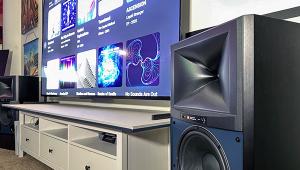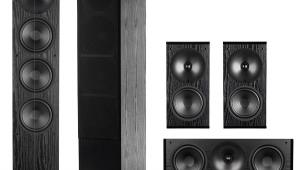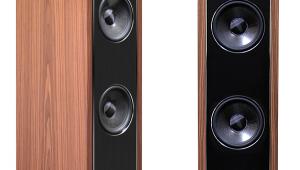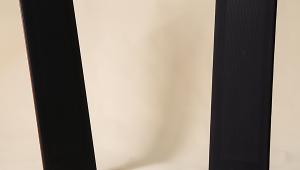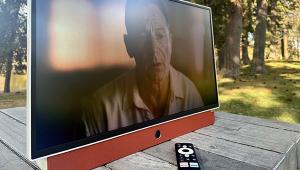A common problem is the creation of a ground loop (buzzing) in speakers if you use an amplifier and a subwoofer (another amp) on the same circuit (breaker)--> they "fight" for control of the ground. So my question is do the BP-8080STs create a ground loop if they (with two amps) are on the same circuit as the amplifier in your room?
Definitive Technology BP-8080ST Speaker System Page 2
Front and Center: More Power
The CS-8080HD center ($999) is also newly designed and matched to the BP-8080ST. It uses the same new BDSS midrange drivers and 1-inch aluminum tweeter in front. It also houses—wait for it—a scaled-down, built-in, DSP-controlled powered sub with 300 watts of Class D power, an active 5-by-10-inch woofer, and two 5-by-10-inch passive radiators that fire out of the top (or over the top if you’re looking for editorial perspective).
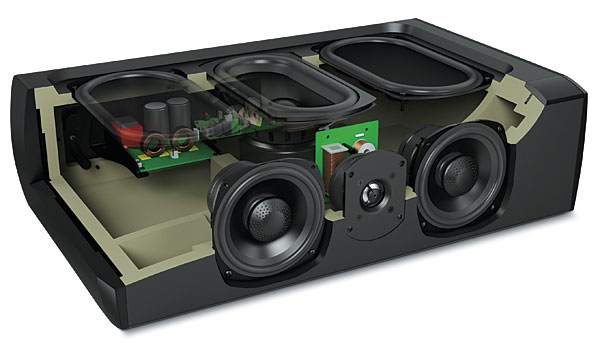
The horizontal arrangement of the dual midrange drivers with the tweeter in the middle is the most common among center speakers, but it’s not necessarily the most desirable. One of a center speaker’s primary duties is to anchor dialogue for offaxis listeners, but a horizontally arranged midrange/tweeter/midrange array inherently exhibits ragged off-axis frequency response. On the other hand, in practice, in my house, I’m typically right in the sweet spot, with my loved ones not far off to either side.

With small, inquisitive children in the house, it didn’t work for me to test a full system with SR-8080BP surround speakers, which Definitive recommends for use with the other speakers tested here for a full 5.1-channel system. The SR-8080BP retails for $698 per pair, so a total flagship bipolar Super Tower–based 5.1-channel system would cost $4,695. I’ll let a little bit of cat out of the bag right now and note that this is a heckuva lot of speaker performance for the money.
Setting Up and Configuring Things Out
Placing the speakers was a snap. They worked extremely well in nearly the same spot I place my reference speakers, which is a good ways out from the wall behind them (almost 4 feet) and nearly as far from the side walls. Center to center, the two towers were 8.5 feet apart and just over 10 feet to the listening position. My reference speakers also include built-in powered subs, and it’s an underrated concept. Integrated powered subs let you pull the speakers out into the room where they’ll image best, while the adjustable sub level helps mitigate the drop in bass output that normally occurs when you move a passive speaker farther from the room boundaries. Too often, users have to seriously compromise one of these performance attributes in favor of the other with traditional full-range passive designs. Another major advantage of having two powered subwoofers in your main speakers is that you’ve got two subwoofers and you haven’t even bought one. While the towers are slim, you’ve got a 12-inch powered driver with two big passive radiators in a pretty good-sized cabinet in each speaker. And loading the room with bass from two positions almost always results in smoother in-room bass response than you’d get from a single sub. A single sub is more likely to be finicky about where in the room it will deliver its best performance at multiple listening positions.
There are two ways to use the BP-8080STs as LFE subwoofers in a surround system. You can simply select None for the subwoofer in your surround processor or A/V receiver, which will redirect the LFE/.1 channel information (plus the bass from any speakers designated as small) to the left and right speakers. Or you can spend some extra cash and run line-level interconnects to each tower’s LFE input and select Yes for the subwoofer. (If your processor or AVR only has one LFE output, there are cheap Y adapters that let you run two cables to the speakers from a single output.) I preferred the latter, and many of you might too, for this simple reason. When you select None for the subwoofer, it means the only adjustment of the powered subs will come from the manual level controls on the speakers themselves. I preferred the manual sub levels at 11:00 and not a hair more for music playback (which I’m very particular about), but I wanted a lot more grunt for movie playback. I didn’t want to manually adjust the speakers every time I switched from music listening to movie watching. When I used the interconnects and treated the powered subs like a separate sub, I could adjust the sub/LFE level in my surround processor and save to memory a movie config with the desired levels for movie and music listening. This will also work with an AVR if you roll that way. Just about any recent-vintage surround processor or AVR will have similar functionality.

As an aside, I like using a trusted auto setup and room EQ—the Anthem D2V’s Anthem Room Correction (ARC), in my case—for movies but not for music. I’ve found that ARC adds welcome punch, definition, and impact to LFE and bass in general for movies, but room EQ just sounds a little too canned or processed for music. So I use EQ for movies but not for music listening. Your AVR or processor likely has a direct or bypass mode of some kind that can take the room correction and most processing out of the loop. Try it and see if you like it with music.
The Music
With music, I immediately heard the things I loved in that August demo, but even more so. These speakers loved being out in space in my biggish room. The soundstage had an absolute majesty. It was big and lifelike, but unlike many audiophile speakers I’ve heard that are known for this attribute, it wasn’t artificially big. Some designs I’ve heard can make a three-person a capella sound like a full choir. But here, I was tremendously impressed by the focus of vocals and instruments, which I haven’t heard from Definitive’s bipolars before. Jeff Tweedy’s up-front vocal and acoustic guitar on Wilco’s “You and I” on vinyl from Wilco (The Album) was fully fleshed out and three-dimensional, far behind and in between the two towers. A lot of jazz recordings are big on fully realized imaging and recording-room sound—if you’ve never heard it, check out John Coltrane and Johnny Hartman on any format you can find. The splashes of ambience of the recording space are convincing and knock up a notch still with live recordings. Neil Young’s Live at Massey Hall is still one of my favorite records, and these speakers nailed it. Young and his guitar were locked firmly in space, and the auditorium and audience sounded lifelike and very present without robbing one bit of the extraordinary focus. I’m a bigtime imaging guy, and there’s a lot to love here.
You know what? You don’t buy speakers with built-in powered subs to live in acoustic jazz land. You want to rock? These speakers are your new BFF. The Definitives rendered bass, especially acoustic bass, with weight and punch that I can’t imagine a passive design in that position in my room being able to equal. Just as important, there was a nimble clarity that carried a tune’s rhythm and pace effortlessly. On the Eagles’ live Hell Freezes Over set, these speakers rendered the big, booming bass drum with a real live concert sock in the guts in terms of extension, sound pressure level, and dynamics. I didn’t see this tour, but after I listened to this, I’ve felt it. When I moved to heavier, faster rock, these speakers loved them some Nirvana and some White Stripes, both of which feature big, explosive drum kits and in the case of Nirvana, some very crisply defined bass riffs. Tunes with deeper synthesized bass like Nine Inch Nails or Paula Cole’s “Tiger” from This Fire went quite deep and played loud but didn’t quite hit the most subterranean notes where I had the speakers placed. When I moved the speakers back toward the wall behind them, there was more heft in the bass, but it also left behind some of that spatial majesty I raved about earlier. Most people have never even heard the notes I’m talking about, and people who have most certainly have big, costly dedicated subs. I haven’t heard a passive speaker deliver bass anything like this in a room anywhere near this size or as far out in the room. On any reasonable material, you’ll be impressed with this speaker’s bass.
- Log in or register to post comments


How do the BP-8080ST compare to the Mythos ST for music and movie?

I bought the definitive mythos bipolar towers, center and surround. The manual says to configure manually because automated programs won't properly calibrate bipolar speakers.
Is this true for Audyssey? I read in the review that you liked using a trusted auto-setup!

MuleSoft MCD-Level-2 Exam Questions are study materials designed to aid in the preparation for the MuleSoft Certified Developer - Level 2 (MCD - Level 2) certification exam. These dumps typically include a variety of practice questions and answers, offering candidates the opportunity to assess their knowledge and readiness for the actual exam.
While MCD-Level-2 dumps can be a helpful resource for self-assessment, it's crucial to emphasize that comprehensive exam preparation involves using a variety of study materials. Candidates are encouraged to complement these dumps with official MuleSoft documentation, hands-on practice, and other relevant resources to ensure a thorough understanding of the exam objectives.
The MCD-Level-2 certification is designed for MuleSoft developers who want to demonstrate their advanced skills in designing, building, testing, deploying, and maintaining MuleSoft applications. As with any certification, a well-rounded and practical approach to learning is key to success.




